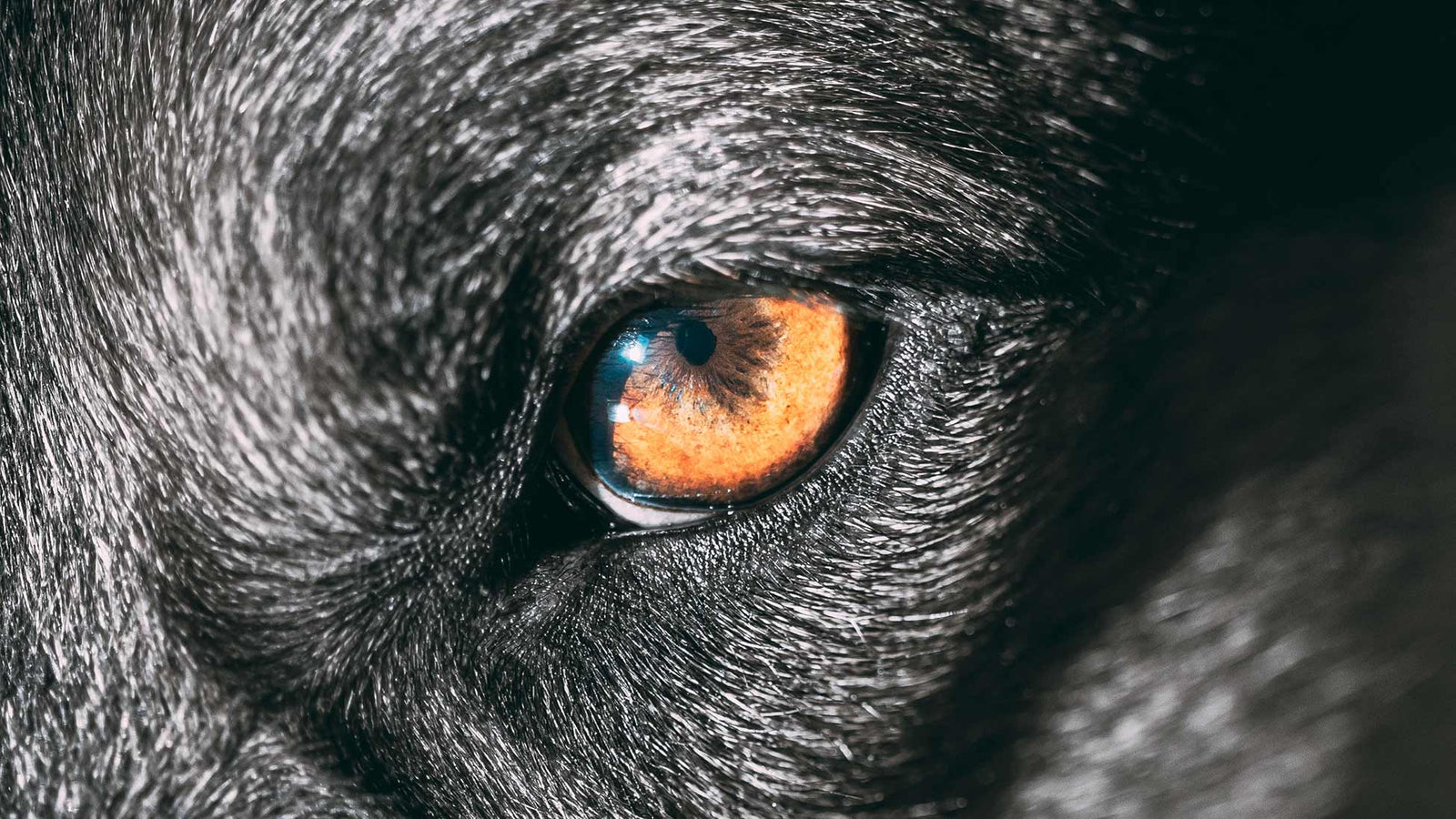You probably already know that dogs see the world quite differently than humans. When digging through different resources, you’ll find often-cited facts like “dogs have 20/75 vision” (compared to our standard for good human vision of 20/20), or “dogs have dichromatic vision” (which is similar to red/green color blindness in humans). But (pardon the pun) we may not be seeing the whole picture. And even though it’s difficult to compare apples and oranges, our own vision is the only way we know of seeing, so, it’s easiest to compare dog vision to our own while acknowledging the fundamental differences.
Also, we’re going to make some mastiff-sized generalizations and simplify a lot of facts to keep this to one article.
The Physical Differences Between Dog & Human Visual Systems
Both human and canine visual systems are made up of the same core components:
- Two Eyes: to absorb information
- A Central Nervous System: to interpret that information
But while there are seemingly endless differences between human and dog central nervous systems, many of the differences between how dogs see and how humans see can be traced to the differences in their eyes.
Both dog eyes and human eyes are made of the same components and building blocks. Both have corneas, lenses, retinas, optic nerves, and some other stuff we won’t get into. The corneas and lenses work like a camera to let in an image in the form of light. That image is read by the retina and forwarded via the ganglion cells (which form the optic nerve) to the central nervous system for interpretation. Think of the cornea and lens like the shutter and the retina like the image sensor (or film if you’re that old or that cool).
The Retina
If you were looking through dog eyes, some of the biggest differences you’d notice would be related to the retina. The retina is made up of three types of photoreceptors: rod opsins, cone opsins, and ganglion cells. Rods and cones both absorb photons (light particles) and relay messages through the ganglion cells about that light.
- Rods are generally found in the periphery, interpret light levels, detect motion, have low spatial acuity, and are responsible for low light vision.
- Cones process color and detail, and are most active in higher light environments.
- Ganglion cells receive inputs from the cones and rods and transmit image information to the brain, where the image is assembled.
Most animals have some combination of rods and cones in their retinas, but the numbers of each differ, with extremes existing on both ends. If an animal has very few or no rods, it can likely only see during daylight, while an animal that lacks cones, cannot see color. Dogs have about one cone for every 20 rods, meaning that their eyes have developed to prioritize properties like light and motion, over details like color. In fact, one study of police dogs showed that the dogs could recognize a moving object at 810 to 900 meters away, but that distance of recognition was reduced to 585 meters when the object was not moving.
How Far Can Dogs See?
Dog eyes excel at detecting motion at a distance but have trouble recognizing stationary shapes at the same distance. They can recognize a moving object at up to 900 meters, but can only see that same object at 585 meters when stationary. When it comes to detail, most breeds must be 20 feet from an object to see it in the same detail as humans see it at 75 feet.


Unlike dogs, humans (and all primates) have a cluster of cones in their retinas called a foveal. What do you get when you take the detail-oriented photoreceptors and cluster them? An increased emphasis on detail, including color. Dogs don’t have foveal vision, but they do have a visual streak that substitutes for some visual acuity but does not reach the levels of the foveal in humans.
In fact, humans are so attuned to detail-oriented vision, we can even see better detail in dim light conditions, discerning objects at three times the distance than dogs. However, it needs to be noted that those objects are stationary. Once you include motion, a dog eye’s population of rods far outperforms the human eye in the dark. Actually, dogs (and many other vertebrates) have a special formation in the eye called the tapetum lucidum, which reflects light back across the photoreceptors, giving them a second chance to capture an image. Since dog photoreceptors excel at motion detection, this second chance to capture light, is like a power-up, allowing dogs to see motion exponentially better in the dark. Because it’s reflective, tapetum lucidum is also what makes dog eyes appear to shine in the dark.
Can Dogs See in the Dark?
The tapetum lucidum allows dogs to see motion far better than humans in the dark. Since human eyes see detail better than dogs overall, humans can also see detail better in dim light.
Further separating humans from dogs in the detail-oriented stats are the types of cones. Humans have three types of cones that absorb three different wavelengths (or colors) of light: Red, Green, and Blue. This allows us to see a spectrum of light, including red, orange, yellow, green, blue, indigo, violet, and shades of grey. Dogs, on the other hand, only have two types of cones, Blue and Yellow, which allow them to only see blue, yellow, and shades of grey.
What Colors Can Dogs See?
Dogs can only see blues, yellows, and shades of grey.

While the cones and rods are absorbing color, light, and movement, they relay that information to the ganglion cells, which then transmit all image information to the brain. Dogs have far fewer ganglion cells than humans (about 170,000 in dogs and 1,200,000 in humans) and therefore are able to transmit less information. Combined with having fewer cones (the detail-oriented photoreceptors) it’s like a smaller resolution digital image relayed to the brain — one where you can see the chunky pixels when you stretch it. Yes, you can tell what it is, but it doesn’t have the detail of a higher-resolution image.
Veterinary Ophthalmologist, founder of the Animal Eye Center, and founding investor of Rex Specs, Dr. Steven Roberts DVM, DACVO, explains, “In dogs, four cones typically send information to one ganglion cell. From the perspective of the ganglion cell, it does not care which of the four photoreceptors sends the information, it responds the same, regardless. Thus, humans will have at least a visual resolution four times greater than a dog.”
What is a Dog’s Visual Acuity & What Does it Look Like?
Dogs see detail at 20-40% less than humans in both light and dim light conditions. With a higher ratio of rods to cones in a dog’s eyes, they are more attuned to sensing motion with their eyes than detail. If you were to see an image through a dog’s eyes, it might look like a low-resolution digital image that has been stretched.
The Lens
While the rods and cones absorb light, it’s the lens that determines how the light converges on the retina. As light passes through the lens near the front of your eye, it directs light to the retina at the back of your eye. Where that light hits the eye is called the focal point and to maintain proper vision, the distance between the lens and the focal point needs to be very precise. If it’s too far forward or too far back, the image relayed through the lens will appear blurry (like when a camera is out of focus). If something occurs in the human eye like an elongated eye, the focal point is too far forward, causing things that are farther away to appear blurry. This is commonly referred to as nearsightedness.
So what does that have to do with dogs? Dog eyes are shaped differently than ours and their lenses focus light on their retinas differently. And much like an elongated eye reduces the range of in-focus vision in humans, all dogs have a reduced range of distance (compared to healthy human eyes) at which their eyes can focus. In fact, for most dogs, objects closer than 10-18 inches (or 2-4 diopters) will appear blurry.
How Do Dogs See Things Close to Their Face?
Things like toys held close to a dog’s face or even scratches on a goggle lens appear blurry to a dog at less than 10 inches away.
How Do We See What Dog Eyes See?
Knowing that dogs see less detail, fewer colors, and have a reduced range of vision, helps us interpret what it might be like to have dog eyes when viewing a stationary object. Using the Dog Vision Image Processing Tool, we can estimate how dogs view the stationary world, but we don’t have a tool to help us understand how dogs see motion.


Outside the Eyes
Most of the differences in what dogs see and what humans see are a result of the physiological differences of our eyes. But others are right out there in the open, and we can see them every day.
Dogs are Shorter Than Us
Without even looking at their brain, we know that dogs see differently, simply because they’re shorter than humans. Their eyes are, on average four feet below ours, looking up at many things we look down on. Dr. Roberts suggests, “Try viewing the world from 6 inches to 24 inches above ground level to start to understand the difference.”
Binocular Vision
Simply put, binocular vision is the use of two eyes. But having two eyes (both for humans and dogs) allows us to perceive three dimensions. And having two eyes placed close enough, with the brainpower to process and blend the two overlapping images from each eye, gives us an unobstructed view. In humans, that field of view is about 180 degrees.
How Do Goggles Impact Dogs’ Vision?
With an increased field of vision, dogs need more room to see to their sides than humans do. That’s why we emphasize allowing room between the goggle frame and your dog’s eyes when properly sizing your dog for goggles.
Dogs’ eyes are also positioned differently laterally on their head, and this positioning can vary greatly between breeds. Some dogs (usually those with longer noses), have eyes positioned more to the sides of their heads, which gives a field of view of about 290 degrees, while others, with shorter noses and eyes more forward, have a field of view of about 220 degrees.
But a dog’s eye spacing isn’t better in every aspect. Dr. Roberts states, “dogs have a wider field of vision (220 degrees), but a narrower binocular vision zone. Thus, it is correct to say that the 3-D vision of a dog is substantially less than that of a human.”
Do Dogs See in 3D?
Dogs see in 3D but because of their narrower binocular vision zone, their perception of 3D is reduced, or less defined.
What Do Dogs Actually See?
As you may have already concluded, dogs don’t see everything we see, but in some situations, they see more. While the numbers and image processors do a lot to help us see what they see, we need to imagine what it would be like to see movement better. One way to understand what it’s like to have more rods in your retinas is to look at the night sky. Have you ever noticed a faint star out of your peripheral but when you look directly at it, the star disappears? That’s because you have more rods clustered on the peripheral of your retinas, which can detect that faint light in the sky. It’s just a glimpse into what it’s like to have dog vision. A dog superpower, even.

